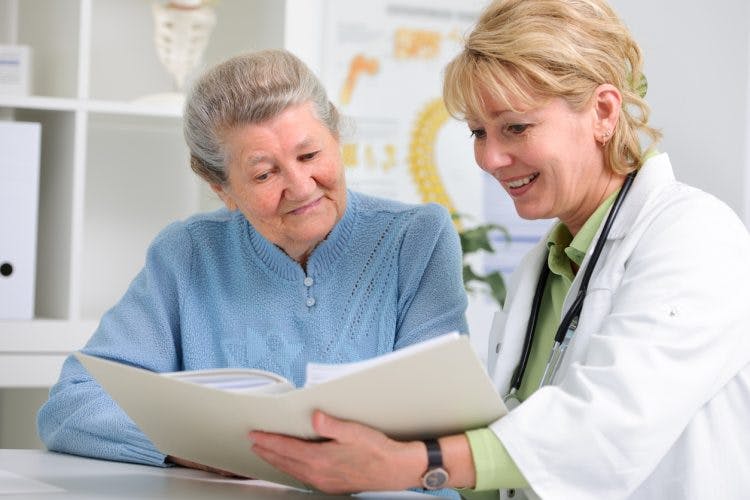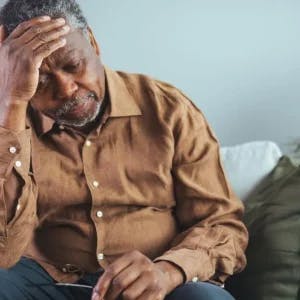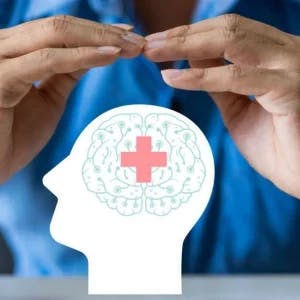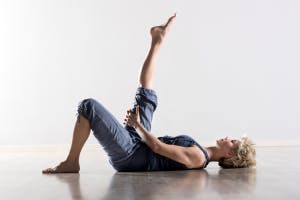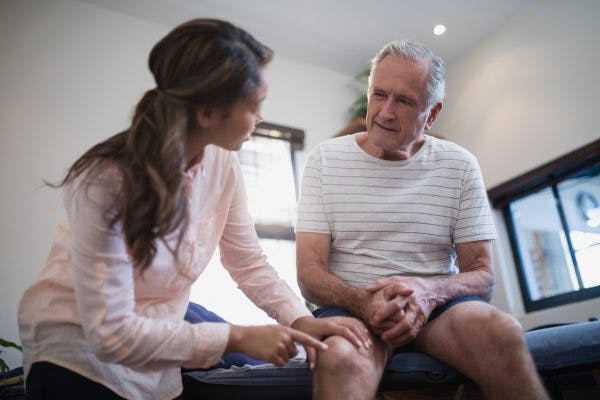Post stroke pain is not uncommon, but management of this secondary effect is often overlooked. After a stroke, survivors often experience a huge shift in their lives that can be difficult to navigate. Management of post stroke pain can feel overwhelming when added to this large list of major life changes following a stroke.
Thankfully, there is a variety of treatment methods available to help survivors optimize post stroke pain management. To help you get started, this article will first review the different types of post stroke pain so that you can better understand what you’re dealing with. Then we will discuss different rehabilitation methods to relieve pain after stroke.
Types of Post Stroke Pain
Pain is a common secondary effect of stroke and can have a major impact on a survivor’s quality of life. One recent study reported that around 30% of survivors experienced pain after stroke. This pain was not just present in the acute stage of stroke recovery but was also seen in the subacute and chronic stages.
Post stroke pain is complex and can involve many different factors. While some survivors experience primarily musculoskeletal pain, others may be affected by nerve-related pain. Before discussing the management of post stroke pain, let’s review the different types of pain a survivor may encounter after stroke:
- Central post stroke pain. This chronic pain condition stems from damage to the central nervous system. It can manifest as intense freezing or burning sensations. As one of the most chronic forms of post stroke pain, it often happens years after stroke and the cause is not fully understood. The resulting hypersensitivity can make mild sensations, like a light breeze across the skin, feel like sharp, intense pain.
- Shoulder subluxation. This occurs when the shoulder begins to “drop” out of the shoulder socket. Subluxation is generally caused by weakness or paralysis of the shoulder muscles after stroke due to hemiparesis or hemiplegia. This poor joint positioning and dislocation often causes pain and can worsen with time, especially when it is not managed appropriately.
- Frozen shoulder. This occurs when the shoulder joint “freezes” and becomes stiff or immobile, usually causing pain in the beginning stages of the condition. Frozen shoulder is common for survivors with hemiplegia after stroke due to reduced shoulder mobility and limited active movement.
- Spasticity. Disruption of the communication between the brain and muscles after stroke can result in spasticity. This is characterized by rigidity or spasm of the muscles and often affects the arm or leg. For example, many survivors experience a clenched hand or curled toes that becomes worse when trying to move actively. When the muscles are in a state of spasticity, this can cause intense pain.
- Contractures. When spasticity worsens or a survivor remains immobile, this can lead to painful contractures. Contractures occur when muscles and joints become progressively short and stiff. This makes it very difficult for the survivor to make any purposeful movement with the affected extremity due to the limited range of motion.
- Neuropathic pain. Many people experience neuropathic pain due to changes in the brain caused by stroke. Neuropathic pain is nerve-related pain and can be chronic. This type of pain can sometimes be called neuropathy or can be further classified as central post stroke pain (CPSP), which we discussed earlier.
It’s important to work closely with your medical team to identify the cause of your post stroke pain so that you can treat it effectively. Once you know the types of pain commonly experienced after stroke, it is easier to identify the treatments that may be most appropriate for your unique symptoms. Next, let’s discuss the different treatments available for post stroke pain management.
Post Stroke Pain Management
While types of pain after stroke vary between survivors, there are many treatment options available to provide relief. It is necessary to work closely with your rehab team to create a post stroke pain management plan that meets your specific needs. Below you will find some of the best treatment options to help address painful symptoms.
1. Physical Therapy
One of the best pain management tools is physical therapy because it helps retrain the brain and the body. This is because physical therapy encourages the brain to rewire itself (through neuroplasticity) so that it can correctly send signals to your affected muscles again. Therefore, physical therapy can help ease pain by retraining neural pathways and pain-free movement patterns.
Additionally, participation in active and passive rehab exercises can reduce spasticity and help prevent or treat frozen shoulder. Movement can also help regulate your body’s vital functions and reduce the risk of developing complications like contractures or muscle atrophy. Unfortunately, central post stroke pain does not always respond well to physical therapy. However, there is hope in other treatments we will discuss below.
2. Electrical Stimulation
Physical therapy can be even more effective when paired with electrical stimulation. This involves applying electrical currents through electrodes placed on the skin to reduce pain-related signals to the brain.Many types of post stroke pain may benefit from electrical stimulation, including central post stroke pain and neuropathy.
Specifically, patients with central post stroke pain or other nerve-related pain can benefit from TENS, a form of electrical stimulation. If you feel this could help manage your painful symptoms, talk with your doctor or therapy team to get started.
3. Adaptive Equipment
There are many different forms of adaptive therapy tools and equipment that survivors of stroke can use to improve their quality of life. In fact, there are specific occupational therapy tools available that can make activities of daily living easier for survivors to increase their independence.
For shoulder pain, arm slings or shoulder braces can help by relieving strain on the shoulder ligaments and improving the positioning of the shoulder joint. This can be very beneficial for survivors experiencing pain due to shoulder subluxation.
Additionally, certain hand splints and gloves can help reduce swelling and prevent contractures. Keep in mind that it’s important to continue physical and occupational therapy exercises, though. Adaptive equipment alone is not enough to treat the secondary effects of stroke and, without treatment, the painful symptoms will likely worsen over time.
4. Botox
If your pain is mostly caused by spasticity, then Botox may help. Botox is an FDA-approved treatment for spasticity that temporarily reduces spasticity after stroke. Then, when the Botox is in effect, you can continue physical therapy to benefit from the improved mobility this provides.
Usually, you will need repeat treatments because the Botox will eventually wear off. However, by participating in physical therapy simultaneously, you’re getting the brain on board. This means that you can retain some of your gains in improvement even after the Botox wears off.
5. Medication
Medication can be an effective post stroke pain management treatment. Specifically, medications can help reduce spasticity and provide relief from some types of neuropathic and musculoskeletal pain. Your doctor can identify the best pain medications for your unique condition.
While central post stroke pain is less responsive to medication, certain drugs can help address this condition. For example, amitriptyline (an antidepressant medication) can sometimes reduce painful symptoms. Additionally, some anticonvulsant drugs like gabapentin and pregabalin can help reduce spasticity and pain.
6. Mirror Therapy
Mirror therapy can help improve mobility and reduce spasticity after stroke – especially in the arm and hand. Furthermore, mirror therapy may even help central post stroke pain, too. One study found that it helped reduce central post stroke pain in a patient 5 years after a thalamic stroke. While the study was small, this holds promise for easing central pain.
Mirror therapy works by activating neuroplasticity, much like other therapy exercises. When the affected limb is covered by the mirror, the reflection of your unaffected limb performing the exercises can “trick” the brain and encourage neural rewiring. Plus, this treatment is non-invasive, which makes it accessible from home.
7. Support
Living with pain is tough to say the least, and a strong support system can help reduce or prevent emotional side effects like depression. Calling in the support of friends and family during this time is essential for recovery. Also, see if you can locate support groups for stroke survivors in your community or online to help create an encouraging network as you recover.
In addition to seeking support from those around you, there are many other resources available to help you cope with these major life changes. For example, the book Healing and Happiness After Stroke can help encourage survivors to keep pushing forward toward recovery. This is just one of many motivational books you can access to help you along your rehabilitation journey.
8. Distraction
While this may sound strange, distraction can be a great post stroke pain management technique. Even though staying busy can require painful movements, the benefits often outweigh the costs. While it can be uncomfortable to move about and do work, it can help survivors feel more in charge of their lives instead of feeling like the pain is in charge.
Staying active and moving your body can also help retrain the brain and decrease pain intensity. Furthermore, finding an activity or hobby that you can participate in with minimal increase in pain can help you feel empowered and more independent. This mindset can help you build resilience against post stroke depression or the feelings of grief that may follow post stroke pain.
Post Stroke Pain Management: A Summary
Pain following a stroke exists on a broad spectrum and affects each survivor differently. Post stroke pain can be neuropathic or musculoskeletal and is often accompanied by other secondary effects. This can include spasticity, contractures, or more complex conditions like central post stroke pain.
Thankfully, there is hope for relief from post stroke pain using different management techniques. Treatments like physical therapy, Botox, adaptive equipment, and medication are just a few ways to help reduce painful symptoms after stroke.
Nerve-related pain like CPSP responds best to electrical stimulation, mirror therapy, and distraction. These treatments can also be combined to help maximize relief from pain. Talk to your rehab team to determine the best options to meet your specific needs.
We hope this guide has provided hope for managing post stroke pain. While pain is complex, there is always the potential for improvement. Pursuing treatment for your painful symptoms can allow you to progress more quickly toward your goals after stroke and motivate you on the road to recovery.

